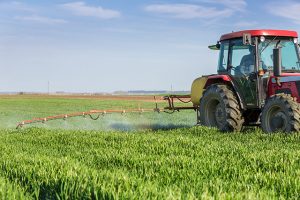
Triazole — toxicity, side effects, diseases and environmental impacts
Tuesday, November 14, 2017 by Michelle Simmons
http://www.naturalpedia.com/triazole-toxicity-side-effects-diseases-and-environmental-impacts.html

Triazole, introduced in the 1980s, is a chemical family of fungicides used to fight against crop diseases such as powdery mildews, rusts, and leaf-spot in a wide variety of plants, such as field crops, orchards, vegetables, and turf. Triazole fungicides have common metabolites: the free triazole compounds 1,2,4-triazole, triazole alanine, and triazole acetic acid. Triazole alanine and triazole acetic acid residues are mainly associated with plant commodities, while 1,2,4-triazole is primarily associated with animal commodities. Triazoles act by inhibiting the biosynthesis of sterol, which is a component for the integrity of fungal cell membranes. Other members of triazole include cyproconazole, difenoconazole, fenbuconazole, flutriafol, ipconazole, metconazole, myclobutanil, propiconazole, tebuconazole, tetraconazole, triadimefon, and triticonazole.
Triazole fungicides can be in the following forms: emulsifiable concentrate, suspension concentrate (flowable concentrate), paint, liquid, water dispersible granules, other liquid applied undiluted, flowable concentrate for seed dressing, suspoemulsion, dust, powder, wettable powder, emulsion (oil in water), or microencapsulated. It has the molecular formula of C2H3N3.
List of known side effects
A few known side effects of triazole to humans include redness and pain in the eyes. On the other hand, the chemical has been found to be harmful to aquatic organisms.
Body systems affected by triazole
There are a few body systems that triazole can adversely affect. One of these is the ocular system. If the chemical gets in contact with the eyes, it may cause serious eye irritation and damage. Another body system that the chemical compound can negatively affect is the reproductive system. It may damage fertility or harm an unborn child. Moreover, triazole can also affect the respiratory and integumentary systems as it can cause irritation in the respiratory tract and skin.
Items that can contain triazole
Triazole can be found in fungicide products used to control diseases of turfgrasses, vegetables, citrus, field crops, and ornamental plants. The chemical can also be present in homeowner products that may be easily acquired at garden and nursery retail centers. Triazole fungicides are used as foliar sprays and seed treatments.
How to avoid triazole
According to the Centers for Disease Control and Prevention (CDC), there are several ways on how to prevent triazole exposure. One of these ways is to have a local exhaust in the area to avoid inhaling the chemical. Moreover, using a breathing protection will give you extra protection from the chemical. To avoid skin contact, using protective clothing and protective gloves is a must.
Where to learn more
- Chemical Could Revolutionize Polymer Fuel Cells (press release)
- Overused fungicides give rise to deadly, resistant fungus threatening humans and crops
- Chemicals.news
- Toxins.news
- DangerousMedicine.com
Summary
Triazole is a family of fungicides used to fight against crop diseases such as powdery mildews, rusts, and leaf-spot in a wide variety of plants.
Triazole can cause redness and pain in the eyes, serious eye irritation, and serious eye damage.
Triazole affects the reproductive system by damaging fertility. It may also harm an unborn child.
Sources include:
Tagged Under: Tags: Triazole






